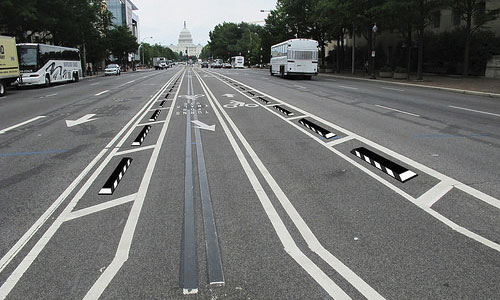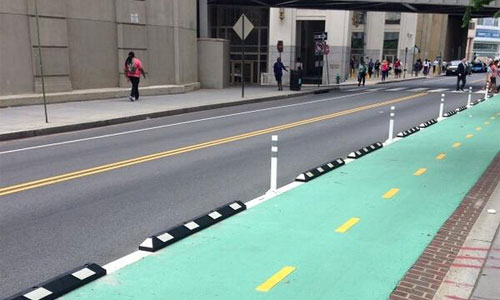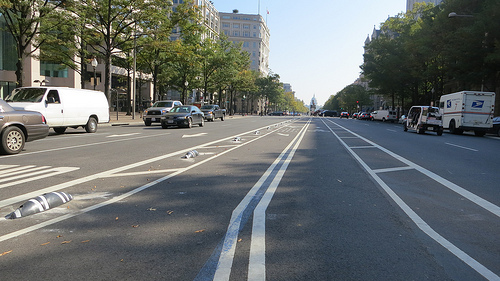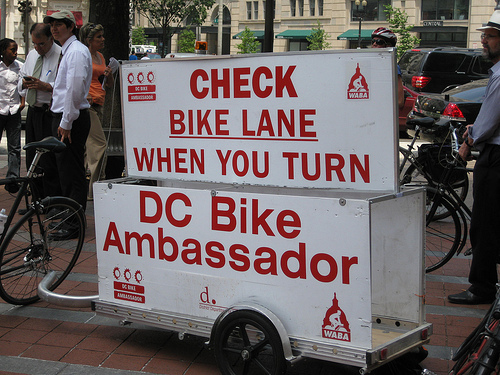Maybe this can stop U-turns on Pennsylvania Avenue
Past efforts to stop dangerous and illegal U-turns across the Pennsylvania Avenue bike lanes have not had much success, but DC officials are ready to try a new approach with a product, known as a “Park-It,” that usually serves as a wheel stop in parking spaces. Will this do the trick?
Last fall, crews from the District Department of Transportation (DDOT) installed a product called a Zebra, from the Spanish company Zicla, along one block of Pennsylvania Avenue as a test. They studied the number of illegal U-turns before and after the Zebras went in.
While this study was not particularly scientific, there were fewer U-turns within the test block. However, U-turns in the surrounding blocks increased. This suggests drivers just waited to make their illegal turns after passing the barriers, but it did prove that these types of barriers are relatively effective in cutting down on U-turns.
Park-Its will make more of a barrier than the Zebras
Park-Its are 6 feet long and slightly lower than the Zebras. According to a letter from DDOT to the US Commission on Fine Arts (CFA), one Park-It will go in each of the spaces between stripes along the buffer area on both sides of the bike lanes, with a maximum of 8 feet in between. On the sections where there is no crosshatched, painted buffer, such as between 13th and 14th Streets, the Park-Its will go even closer together.
The Park-It will use the same black and white color palette which CFA asked for with the Zebras. These Park-Its are already also in place along the edge of the new 1st Street NE cycletrack.
This will be a drastic improvement from the Zebras, which were spaced much farther apart than the manufacturer recommends. This happened partly because the contractor striped the buffers differently from what was in the original plans, and the bike planners were unknowingly using inaccurate plans to design the Zebra test.
Unlike with the Zebras, this is not a pilot program. Park-Its will go along the entire length of Pennsylvania Avenue from 15th Street to Constitution Avenue. They will not go on the last half block to 3rd Street, because there is parking in the center lane.
Why DDOT is dropping the Zebras
DDOT officials chose not to expand the Zebras for a couple of reasons. First, people reported that drivers found it easy to drive over the Zebras. Second, the test raised concerns about the long-term maintenance and durability of the Zebras. The winter was not kind to the Zebras, with multiple scarred and broken Zebras scattered across the block from impacts with vehicles and snowplows.
A Park-It costs only about half as much as a Zebra, so replacement and maintenance will be more cost-effective. There are also multiple suppliers. The recycled rubber used in Park-Its has some “give” and should resist impacts better than the hard plastic material of the Zebra. Lastly, in order for the Zebras to be effective, there would need to be many more of them.
DDOT crews will install the Park-Its this summer. Afterward, the bike planners will monitor the area to count illegal U-turns and keep an eye on the Park-Its’ durability.
New traffic signals will come one day
The DDOT letter to the CFA also says they will install bicycle signals on the current traffic lights. Right now, signs point to green arrows on the signals, and tell cyclists to go when those arrows are green. Bicycle-specific signal heads would make it possible to independently let bicycles and vehicles go through an intersection.
DDOT may allow drivers to turn left at more intersections where they currently can’t, and/or let cyclists ride through the intersection at a time when drivers cannot. This could reduce drivers’ desire to make illegal U-turns in the middle of the block.
DDOT officials have given no timeframe for the signal changes. However, they wanted to give CFA a complete overview of all planned changes at one time.
CFA’s agenda for this Thursday lists this project on the “consent calendar,” meaning that CFA staff don’t think it even needs to be discussed at the hearing and the board can potentially approve it along with other consent items without any debate.
Will this increase safety along Pennsylvania Avenue corridor? Hopefully. If this doesn’t work, perhaps nothing will. Since Pennsylvania Avenue hosts an inaugural parade every four years, it’s not possible to build anything more permanent in the street. But this barrier is the strongest step DDOT has taken thus far to curb U-turns, and cyclists are sure to welcome it.




